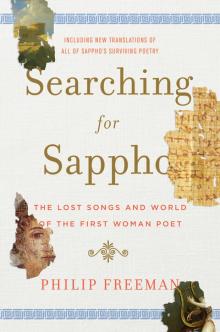- Home
- Philip Freeman
Searching for Sappho Page 7
Searching for Sappho Read online
Page 7
Males were thought to develop more quickly than females, as they were made from stronger seed, moving in the womb after three months while girls took four. This gender difference was supposedly observable in the mother herself, as she would have a healthy complexion with a male child and a pallid face with a female. Boys were also thought to be carried on the right side of the mother’s body, while girls grew instead on the inferior left side.
Women reportedly faced many medical risks during pregnancy, from fevers to an unnatural craving for harmful foods. A mother was thought to be at greatest risk of miscarriage during the first forty days of pregnancy and was advised, among other warnings of risk factors, to avoid stepping over a raven’s egg. Aristotle advised pregnant women to exercise and eat well but to avoid salt and wine. Physicians were divided about whether or not pregnant women should avoid sex. Some thought an orgasm could bring on miscarriage, though Aristotle believed intercourse could be beneficial for women until the eighth month of pregnancy.
WHEN SAPPHO GAVE birth to Cleis, it would have been in the women’s quarters of her household surrounded by female friends and family members. We don’t know the details of this or any other birth in ancient Greece from a woman’s point of view, since neither Sappho nor any other woman writer mentions it. This information is also incomplete because it consists of accounts from male physicians, who were normally present only at life-threatening deliveries. If no problems were anticipated in the labor, the men of the household withdrew to their own quarters or left the home altogether. Birth was the business of women.
The date of a child’s delivery could hardly be controlled, but the ancient Greeks believed certain days of the month were more auspicious than others. A century before Sappho, the poet Hesiod advised that the sixth, ninth, tenth, and sixteenth of each month were favorable for the birth of boys. Only two days, the ninth and fourteenth, were thought promising for girls.
Midwives were employed to help the expectant mother not just in the hours of delivery, but in the days before and after the birth. A midwife was known as a maia (“good mother”) or omphaletomos (“cord cutter”) and was skilled at the medical, psychological, and religious aspects of delivery. She was typically an older woman who had given birth herself and was beyond childbearing years. Midwives were encouraged to be intelligent, respectable, and strong enough to handle the physical demands of bringing a child into the world. The physician Soranus also recommended that they have long, thin fingers and keep their nails well trimmed.
After a midwife was called to the home, she would begin by purifying the birthing room with rituals and prayers to the goddesses of childbirth. Hera, the wife of Zeus, was among these, as was the virgin Artemis, but it was Hera’s daughter Eileithyia who was most closely associated with labor. When Alcmene, the mother of Hercules, was ready to give birth, Hera in a jealous spite sent Eileithyia to wait outside the women’s quarters of the house and delay the birth by whispering spells and sitting with her legs tightly crossed. A clever old woman attending the birth noticed the stranger in the courtyard and understood then why her mistress was suffering so long in agony. She tricked the goddess into thinking the child had been born and broke the spell so that Hercules could be delivered. Eileithyia was furious and turned the old woman into a weasel. Normally, though, goddesses of birth were thought to be quite sympathetic to women in labor.
When the actual time for delivery came, the midwife and other women present prepared the expectant mother and tried to ease her fears as much as they could. But birth could be a frightening business, especially for the first-time mother. As Medea, a mother twice over, says in a play by Euripides:
I would rather stand in battle three times than give birth once.
Some midwives had the woman stand and hold tightly to a post; others urged the patient to lie down in bed. But as one woman in labor was claimed to have said: “Why would I want to go to bed? That’s how I got into this mess in the first place!”
The most common position for delivery was sitting on a stool or birthing chair—a technique that allowed gravity to aid in the delivery. In representations in Greek art, we see the laboring mother sitting half-naked in such a chair with her hair loose as she is supported by assistants on either side. If a birthing seat was not available, a woman might sit in the lap of another woman, who would hold her tightly.
A midwife would apply a variety of lubricating ointments for easier delivery. Aristotle believed that the birth of baby boys was more painful and difficult than that of girls, on the reasonable grounds that boys tended to be larger. But boy or girl, an experienced midwife stood ready with the tools needed to handle any contingency of birth. These included olive oil, hot water, sponges, wool, bandages, soothing perfumes for the mother, and a pillow for the newborn infant.
If the delivery became protracted, a midwife could employ several techniques to speed things up, such as shaking the woman up and down, wrapping her genital area tightly in a blanket, or having the mother-to-be lie facedown on a couch while the women present grabbed her legs and pulled them to encourage the child to come out. Correct breathing was also said to help, as was induced sneezing and eating small portions of wolf meat.
When at last the baby was delivered, the women let loose a shout of joy. The midwife would then cut the umbilical cord at a distance of four fingers from the baby’s belly with a piece of broken glass or a potsherd. Iron knives were thought to be ill-omened for this important ritual. The exhausted mother and newborn child were then bathed in pure water drawn from a spring, if available, both for cleansing and to begin removing the ritual pollution that was believed to be caused by childbirth. For this act, some physicians recommended wine (as was the custom in Sparta) or the urine of a young child. Visitors would have been discouraged by the religious impurity associated with birth.
Not all births went well, for either the mother or the child. The maternal mortality rate is difficult to determine, but as many as one in ten women may have died in childbirth. In Sparta these women were listed as heroes along with men who fell in battle. In Athens as well, they were honored with tombstones showing them in labor. In many instances it seems the Greeks had no viable way to deal with difficult births. Cesarean sections were practiced, but only as a last resort, since the risk to the mother through blood loss and infection was enormous. When a child could not be delivered whole, the midwife usually resorted to the grisly and dangerous technique of dismembering the child in utero to allow the mother to give birth. The gruesome details of the procedure, described in an ancient medical text, do not make pleasant reading. As an alternative, the physician Soranus recommended using hooks inserted into the obstructed child’s body to forcibly pull it from the womb, a procedure that must have put the mother at great risk and left the baby, if it survived, in a condition that would have made it a likely candidate for exposure.
When a birth was successful, there was great joy in the household, and the new mother, above all, was grateful to the gods for a healthy child. It was the custom soon after the birth to thank the goddesses of childbirth by making an offering of clothing worn during the delivery. One third-century-BC inscription by a new father and mother shows that men, too, were full of gratitude for the birth of a child: “The son of Cichesias dedicates these sandals to you, Lady Artemis, and Themistodice dedicates these folded woolen garments, because you came gently to her without your bow when she was in labor and held your hands above her.” Such acts of devotion must have been common in Sappho’s age as well. A healthy child meant new life for the family and community that all would celebrate.
But in the days after the delivery, when the excitement of the birth was over and the midwife had gone home, the reality of the radical change in her life would have become very real to the first-time mother. In spite of the help she would receive from other women, the endless work of motherhood was now about to begin.
IN A PASSAGE by the historian Xenophon, a grown son complains about his overbearing mother, onl
y to be roundly condemned by Socrates:
It’s the woman who becomes pregnant, carries the child, risks her life for it and gives it nourishment from her own body. Then when she has brought it into the world with difficult labor, she feeds it and cares for it even though she gets no benefit. The infant doesn’t know who is helping it and has no way of clearly expressing its desires. Still, the mother tries to guess what it needs and wants and tries to satisfy it, toiling through the days and nights never knowing if she’ll someday receive thanks in return.
Aside from this laudatory statement and a few others, ancient Greek literature—even that by Sappho and other women—has very little to say about the life and work of mothers. Like childbirth, it was an area few male writers cared about and reflects a general disinterest by men in what they considered women’s work. This leaves us with severely limited sources on what it was like to be a mother in Sappho’s world. But one window into motherhood is provided by a scant selection of surviving pieces of ancient Greek art. These images are as rare as literary references, but they have the advantage of providing an actual pictorial glimpse into the daily life of mothers and their children.
One such image is from a slender fifth-century-BC oil vase that shows a harried mother holding a sleeping infant in her left arm while a little boy tugs at her robe. Both the mother and the older child look off apprehensively to their right. At the woman’s feet is a basket for wool, while hanging on the wall behind her is a storage sack. This picture shows a wife inside the women’s quarters of her household in her two primary roles, as caretaker of children and weaver of clothing. On the opposite side of the vase is a seated man talking with a woman holding a hand mirror. The images may be unconnected, but it’s also possible that this is the husband and father conversing with a prostitute while his wife cares for their children.
Another vase from the same century shows a mother encouraging her baby boy to crawl to her across the floor. She stands at the right of the image, bent forward slightly with arms outstretched to her son. The baby has pulled himself up on his arms and looks up at his mother with excitement. In the background is a man, probably the father, observing the scene but not directly involved in the action. As must have been the case with most Greek fathers, he leaves the business of caring for and training young children to their mother.
A small Athenian terra-cotta figurine from the fourth century BC is a rare image of a young girl just a few months old. The chubby toddler has her left leg bent up and her arms outstretched as she sits and looks upward, demanding to be picked up by someone who is likely her mother. Her impatience to be taken care of now would be familiar to a parent in any age.
One of the most charming and intimate portraits of a mother and child is depicted on a fine Athenian cup from the fifth century BC. It shows a well-dressed young woman seated on a stool smiling as she reaches out to her infant in a high chair with holes cut out for legs that probably does double duty as a potty seat. The child reaches out to her at the same instant and even lifts its right leg in eagerness. The portrait is a snapshot of an intimate moment, seldom seen in ancient art, when loving mother and child are oblivious to the world around them and absorbed only in each other. The cup was found in the tomb of a wealthy family and may depict a mother who passed away while her child was still young.
Finally, a fifth-century-BC terra-cotta figurine from Boeotia in central Greece shows a mother and daughter at a slightly later stage of childhood and is a unique look at a mother teaching her young daughter to cook. The mother sits in front of a kettle used for heating soup positioned on a low tripod above a fire. The mother leans over the pot to place herbs and spices into it with her right hand, but at the same time she raises her other hand to warn her daughter to be careful of the hot kettle. The girl has her left hand on her mother’s arm for reassurance as she peeks into the boiling pot.
Athenian bowl showing a mother and a baby in a high chair (c. 470 BC).
(MUSÉES ROYAUX D’ART ET D’HISTOIRE, BRUSSELS)
Although mothers were the primary caregivers for their children in ancient Greece, most wealthy families, such as Sappho’s, would have employed a nursemaid to help with a child. Many of these women would have been slaves bought specifically for the purpose of child care. Often they were mothers themselves and skilled at the endless chores of child rearing. If they had given birth recently, they would have been employed to nurse the mother’s child on occasion and give their mistress a much-needed rest. These women often remained in the household their whole lives and became beloved members of the family, such as Eurycleia, the faithful old nursemaid who serves Penelope in the Odyssey. Another such nursemaid, in Aeschylus’s Libation Bearers, looks back on a boy now grown and gives a picture of infant care that still rings true today:
Oh, my dear Orestes, I devoted my life to that child from the moment his mother gave him to me to nurse as a newborn babe. He kept me up night after night with his screaming and crying. Such a fuss he made, and all for nothing. Babies are senseless things, you know. You have to care for them like they were little animals and follow their moods. They can’t tell you what’s the matter, whether they’re hungry or thirsty or have soiled themselves. Babies can’t control their emotions, it just comes out and there’s nothing you can do about it. You do learn to guess in my line of work, but by the gods I was wrong often enough. Then I had to wash his clothes—nurse and laundry woman rolled into one I was.
Aside from a nursemaid, the mother would have had some help from her husband’s mother, who ruled as matron of the house, but the relationship between the young wife and her mother-in-law could be fraught with tension. When a new bride moved into her husband’s family home, as was the custom, she had to submit to the authority of her mother-in-law. This woman would have been much older than her, with great experience in running the household. She likely held the loyalty of the servants and the love of her son, who would have naturally supported his mother in any quarrels with his wife. Doubtless there were many cases in which a daughter-in-law and her husband’s mother got along well, but it wasn’t until the mother-in-law died, usually years in the future, that a wife came into her own. Life must have been easier for a young woman once she bore children, especially sons, but the potential for conflict was ever present. If Sappho did indeed give birth to only a single daughter, her relationship with her husband’s mother may not have been a pleasant one, though she never mentions it in her surviving poetry.
The relationship between a mother and her children as they grew into adolescence and beyond remained close. Sons would move out of the women’s quarters at about the age of six, but they were never far from their mother’s care and supervision. Daughters, on the other hand, resided among the women of the house until the day of their marriage. The loss of a child to illness or accident was every mother’s greatest fear, and many heartbreaking inscriptions on gravestones commemorate the tragic death of a child before his or her time. One such tombstone tells the story of a mother named Xenoclea who could not bear the death of her son:
Leaving two young daughters, Xenoclea, daughter of Nicarchus, lies here dead. She mourned the sad death of her son Phoenix who died at sea when he was eight years old. There are none so unfeeling of grief, Xenoclea, that they do not pity your fate. You left behind two little girls and died of grief for your son, who has a lonely tomb where he lies in the dark sea.
Like all mothers, those in ancient times worried about their children as they grew older and left home. One fragmentary papyrus letter found in Oxyrhynchus, Egypt, preserves the words of mother to her son Ptolemaeus as he pursues his studies far away:
. . . hurry and write to me about what you need . . . I took care to write your teacher and ask about your health and what you were studying. . . . Your sisters send many greetings as do the children—evil eye be gone!—of Theonis and all of our friends.
It shouldn’t be supposed that fathers were uncaring about their children. Once boys had passed the early years of c
hildhood, fathers were usually quite involved in raising and educating their sons. Daughters were dear to most fathers as well, even though girls were primarily the responsibility of the mother. A father’s love for his daughter is seen clearly in an idealized but quite believable scene in Homer’s Odyssey, when young Nausicaa approaches her father, King Alcinous, and asks for a cart so that she can supposedly wash laundry at the river—though, in fact, she intends to spend a day at the beach with her girlfriends:
She stepped up close to him and spoke confidingly, “Daddy dear,
I wonder, won’t you have them harness a wagon for me,
the tall one with the smooth wheels,
so I can take our clothes to the river for washing?
They are beautiful garments, but they do need a good cleaning.
And you’re so busy sitting among the princes and debating in counsel.
You really should be wearing spotless linen . . .
And like any father of a teenage daughter, Alcinous knows well what his daughter is up to, but indulges her anyway.
A mother’s relationship with her children did not end at their marriage, but continued to the end of her life, as we will see with Sappho and Cleis. A son was responsible for the care of his mother when his father died, and the evidence we have shows that most sons assumed the task gladly. A man’s mother would live with him and his wife until the day she died, all the while enjoying the affection of her son and at least the tolerance of her daughter-in-law. A mother’s bond with her daughter also did not end when the girl married, unless her new husband took the daughter far away. Most mothers and grown daughters would have lived in the same area and seen each other regularly during visits to each other’s homes and at religious festivals. A mother would be present at the birth of her daughter’s children, as Sappho surely would have been at the birth of any children of Cleis, and would rejoice in welcoming a new generation of her family into the world.

 Searching for Sappho
Searching for Sappho Saint Brigid's Bones
Saint Brigid's Bones Alexander the Great
Alexander the Great Heroes of Olympus
Heroes of Olympus Sacrifice
Sacrifice